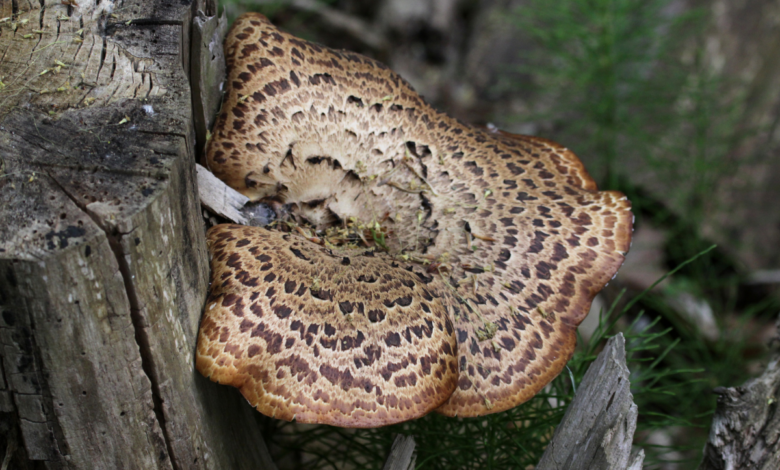The Complete Guide to the Pheasant Back Mushroom

For anyone foraging in spring, morel mushrooms are the prized picks. But what about the underrated pheasant back mushroom?
You have to admit, pheasant black mushrooms are eye-catching. They look like beautiful woodland structures in the wild. The good news is that they are also an excellent woodland treat.
So, are pheasant back mushrooms edible? They sure are!
Before throwing them in your bag, here are a few things you need to know about these mushrooms.
What is the Pheasant Back Mushroom?
The pheasant back mushroom is one with multiple names. Scientifically they are termed as Cerioporus squamosus, which, until recently was Polyporus squamosus.
Yes, species nomenclature can get confusing. On the plus side, I have not seen much confusion about identifying the pheasant back mushroom in the wild.
The name pheasant back comes from the patterns on the top of the scaly cap of a full-grown mushroom that looks like a pheasant’s feathers. The cap is semicircular but can be kidney-shaped as well. It has an off-white or brownish color. The stalk is small, stubby, and covered with a velvety black layer.
Beyond that, they are also known as dryad’s saddle. Dryads or tree nymphs are fantastical creatures from Greek mythology. As per the folklore, these wandering spirits sit on the surface of these mushrooms to rest. Imagine that!
These mushrooms pop up on hardwood trees, logs, and dead stumps in spring, looking like small shelves. You will not find them growing directly on a soil substrate. The larger ones can grow up to 12 inches in diameter while the smaller ones can just be a quarter of an inch. The short and stubby stem is around 1.25 inches in diameter.
Since these mushrooms are polypores, the underside of the cap has angular pores and no gills. They can grow in clusters and some clusters contain as many as 20. Oddly, this mushroom smells different when cut. While some find it smelling like watermelons, I find the scent similar to sliced cucumber.
Where to Find Pheasant Back Mushrooms
Pheasant black mushrooms are found across the globe. In North America, they grow in forests, east of the Rockies. They grow on dead timber and also on the trunks of the living trees.
Like all mushrooms, a damp environment suits them better. Spots that have dead or dying hardwoods, and receive partial sun and shade conditions throughout the day are ideal for their growth.
Pheasant backs prefer hardwoods like silver maple and box elder in the eastern and midwest areas. In the northwestern states, they prefer trees like the quaking aspen. I have also seen them growing on healthy maple trees.
These mushrooms grow during spring, mostly during late April and May. In some states, you might find them growing in June. However, in areas where conditions are ideal, I have seen a few growing in autumn too. You can find them in summer as well, but they will probably be toothier than you like.
If you have found a log with pheasant back mushrooms growing on it, great! You will find them growing in the same spot every year.
How to Forage Pheasant Back Mushrooms?
Thanks to their appearance, these mushrooms are easy to identify. They do not have any poisonous lookalikes either. The pheasant back prefers a temperature range of 65-75 °F for growing. In early spring, check the south-facing slopes and creeks that receive the most sunlight. Since mushrooms prefer high humidity levels for growth, you will find them along creek beds too.
Now, the trick of foraging pheasant backs that are good to eat is to cut them young. Once these mushrooms mature and grow big, the flesh gets too tough for consumption. In general, the smaller ones with a cap size of around 3 inches are the best options. Any larger than 4 inches, they are mostly inedible.
That said, size is not always the correct indicator of edibility. So, passing on a mushroom just by a visual check may not be right.
Try cutting through the white flesh with a knife to determine if it is soft enough. Usually, the flesh turns darker for the older ones. If you are having a hard time cutting through it, it is unfit for consumption. Even with the mature ones, try cutting along the edges that often remain soft. Discard the stem as it turns inedible as the mushroom matures.
Another way is to check the size of the pores. The mature ones will have wider pores similar to a honeycomb and the pores will be hard to remove. In young ones, the pores are as small as pinholes and tightly packed.
How to Cook Pheasant Back Mushrooms?
Anyone familiar with morels will find the taste of pheasant back mushrooms different. Unlike the earthy taste of morels, the pheasant back tastes like freshly cut cucumber. In fact, this is the only mushroom I have seen being served with desserts.
If you do not want to waste the older ones, cut them into thin slices and dehydrate them. Then they can be crushed to a powder for consumption. That is not a choice while you are on a camping or hunting trip though. In case you have collected a few older mushrooms, throw them in your compost heap and follow the right composting tips.
Nutritional content
Not much research has been done on the pheasant back mushroom to determine its exact nutritional benefits. A 100-gram serving of pheasant back contains 77.02 grams of carbohydrates, 17.14 grams of protein, 2.69 grams of fat, and a healthy percentage of fiber. It also contains vitamins B1, B2, B12, E, C, and D.
Additionally, these mushrooms can boost the immune system and have anti-inflammatory properties. They also contain antioxidants like carotenoids, phenolic compounds, and terpenoids. The mushroom has antimicrobial properties as well.
Preparation methods
Many people love the unique taste of pheasant blacks over other mushrooms. Personally, I like morels better, but when cooked right, pheasant blacks are delicious. The best part is, that they are easy to prepare and can be cooked just like any other mushroom variety.
To start with, give them a good rinse, and scrape off the pores with a knife. Next, cut away the hard stem and chop the white flesh into thin slices. Now, they can be roasted, sautéed, and added to soups and stews.
The easiest way of cooking pheasant back mushrooms is to saute them with some butter and salt in a pan. Adding a little wine is a good idea. However, do not cook them for long in high heat. This will dry out the flesh and make it hard. You may add some water to prevent it from getting too dry.
While cooking, ensure that both sides of the mushrooms have turned slightly brown. Once prepared, they can be eaten with a bowl of rice. Try combining them with white meat – turkey or pheasant meat are the best options.
To make it more flavorful, add some onion and garlic. Even better, add a sprinkling of rosemary and parsley. Admittedly, after a tiring hike in the rain, this dish tastes wonderful.
I have also consumed pheasant blacks with pasta with a light cream sauce and they taste delightful. Another option is to cook the mushrooms with spring vegetables and ramen. For more flavor, add some pork to it, along with some tender wild greens.
You can also prepare a pheasant back broth by adding vegetables like chopped carrots and onions. While I have not tried it, cooking these mushrooms with tempura batter is another option. Lastly, you can use a dehydrator to prepare some pheasant back jerky for your outdoor trips.
Final Thoughts
Next time you see the saddle mushroom while foraging, do not ignore it. These mushrooms not only look beautiful but are also one of the best-tasting wild foods out there.
If you are not finding any morels in the mushroom woods, the pheasant back mushroom is an excellent alternative. Even if you are a victim of morel mania, the pheasant back can surprise your taste buds with its unique flavor.
But remember: never forget to exercise due diligence and double-check every piece of mushroom you forage. If there is any chance of chemical contamination of the product, do not collect it.



